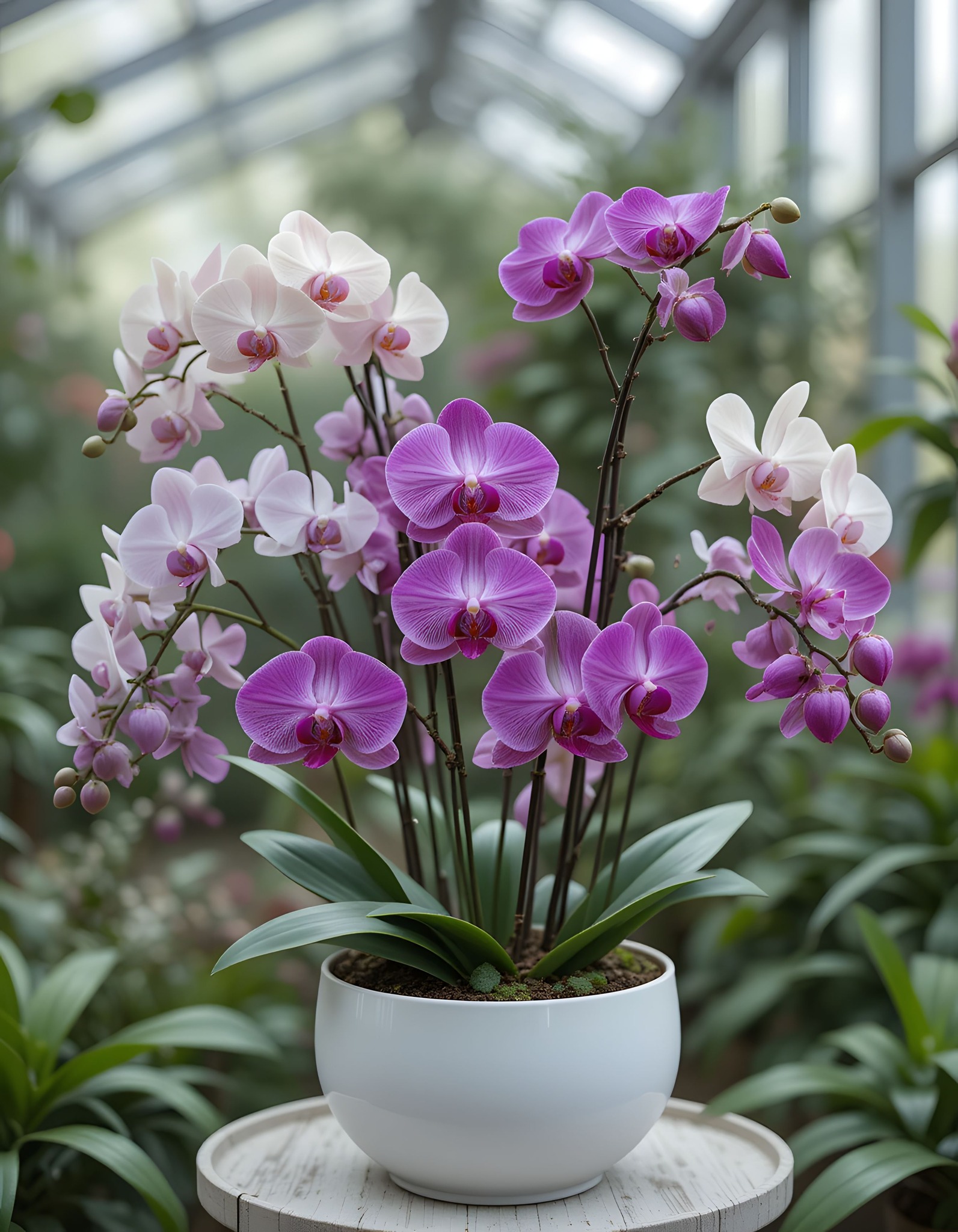Phalaenopsis orchids, also known as Moth Orchids, are among the most popular and stunning orchids grown around the world. With their graceful, colorful blooms and ability to thrive in indoor environments, they’re perfect for both novice and experienced plant enthusiasts. However, to keep your Phalaenopsis orchid blooming and healthy, it’s important to understand its specific care needs. In this guide, we’ll walk you through the essential care conditions to ensure your Phalaenopsis orchid remains vibrant for years to come.
✨ Why Choose a Phalaenopsis Orchid? ✨
Phalaenopsis orchids are adored for their long-lasting, beautiful flowers that come in a wide variety of colors, including white, pink, purple, and even yellow. These orchids have a reputation for being easier to care for compared to some other types of orchids, making them a favorite choice for both beginners and seasoned gardeners. With the right care, your Phalaenopsis orchid can bloom multiple times a year, filling your home with stunning flowers that can last for weeks.
🌞 Light: The Key to Healthy Growth and Blooming
Phalaenopsis orchids thrive in bright, indirect light. They are naturally found in shaded environments under trees in their native habitats, so direct sunlight can burn their leaves and hinder growth.
Optimal Light Conditions:
Bright, Indirect Light: Place your orchid in a location where it can receive plenty of light but not direct sun. An east- or west-facing window is ideal.
Avoid Direct Sunlight: Direct sunlight, especially during the midday hours, can scorch the delicate leaves, causing brown spots.
Signs of Too Much or Too Little Light:
Too much light: If the leaves turn yellow or have brown spots, it may be an indication of sunburn.
Too little light: If the orchid isn’t blooming, it may not be getting enough light. The leaves may appear dark green instead of a lighter, vibrant shade of green.
🌡️ Temperature: Keeping it Just Right
Phalaenopsis orchids are native to tropical climates and prefer warm conditions. Maintaining the right temperature range will help your plant thrive.
Ideal Temperature Range:
Daytime: 65-80°F (18-27°C)
Nighttime: Slightly cooler at night, between 60-70°F (15-21°C)
Avoid Extreme Temperatures: Protect your orchid from drafts, heaters, and cold windows, as sudden temperature fluctuations can stress the plant and prevent blooming.
💧 Watering: Hydrate with Care
Watering is one of the most critical aspects of Phalaenopsis orchid care. Overwatering can lead to root rot, while underwatering can cause dehydration. Striking the right balance is essential to keeping your orchid healthy.
Watering Tips:
Water When Almost Dry: Only water when the potting medium feels almost dry to the touch. This will ensure that the roots aren’t sitting in moisture for too long, which can lead to rot.
Good Drainage: Make sure your orchid pot has adequate drainage holes. Phalaenopsis orchids prefer a well-draining environment, and soggy roots are a major cause of root rot.
Water Thoroughly: Water your orchid thoroughly, allowing water to drain out of the bottom of the pot. Avoid letting your plant sit in water.
Water Frequency: The frequency will depend on temperature, humidity, and the type of potting medium used. During the growing season (spring and summer), you may need to water once a week, while in winter, less frequent watering is necessary.
Watering Method: It’s best to water your Phalaenopsis orchid in the morning to allow the roots to dry out before nighttime. This helps prevent moisture from sitting around the roots overnight.
🌱 Humidity: Keeping the Air Moist and Comfortable
Being tropical plants, Phalaenopsis orchids enjoy moderate to high humidity. Keeping the humidity levels just right will encourage healthy growth and frequent blooming.
Humidity Tips:
Ideal Humidity Level: Phalaenopsis orchids prefer humidity levels of around 50-70%.
Increase Humidity: If your home is particularly dry, you can increase humidity by:
Using a Humidifier: Place a humidifier near your orchid to maintain a constant moisture level in the air.
Pebble Tray: Place your orchid on a shallow tray filled with pebbles and water, ensuring that the pot does not sit directly in the water. This will help raise the humidity around the plant.
Misting: Occasionally mist your orchid with a fine spray of water to increase humidity, but be careful not to get the flowers wet, as this can cause them to rot.
🪴 Potting Medium: The Foundation for Healthy Roots
Phalaenopsis orchids require a specific type of potting mix that allows for proper drainage and air circulation around their roots.
What to Use:
Well-Draining Orchid Mix: A good mix typically consists of bark, sphagnum moss, perlite, and charcoal. This blend allows for good drainage while also retaining the right amount of moisture for the roots.
Avoid Regular Potting Soil: Regular potting soil is too dense for orchids and can suffocate their roots, causing rot.
Repotting Every 2-3 Years: Phalaenopsis orchids need to be repotted every couple of years to refresh the potting medium and give the roots more space to grow.
🌿 Fertilizing: Feed Your Orchid for Strong Growth
During the growing season (spring and summer), Phalaenopsis orchids benefit from regular feeding, which helps them build strength for blooming.
Fertilizing Tips:
Balanced Orchid Fertilizer: Use a balanced orchid fertilizer that is diluted to half strength. Fertilize every 2-4 weeks during the growing season to encourage healthy blooms and roots.
Reduce Feeding in Winter: During the dormant period (usually in winter), reduce or stop fertilizing altogether, as the orchid’s growth slows down.
✂️ Repotting: Refresh Your Orchid’s Home
Repotting your Phalaenopsis orchid is necessary to ensure healthy growth. Orchids do not need to be repotted frequently, but every 2-3 years or when the potting medium breaks down, repotting is recommended.
When to Repot:
Signs Your Orchid Needs Repotting:
The potting medium has broken down or is no longer draining properly.
The orchid outgrows its pot, or the roots become crowded.
How to Repot:
Choose a slightly larger pot to allow the roots to spread out.
Gently remove the orchid from the old pot, trim any dead or rotting roots, and replace the old potting medium with fresh orchid mix.
🪴 Phalaenopsis Orchid Care Summary
Phalaenopsis orchids, with their striking flowers and easy-going nature, can be a joy to grow and care for. Follow these care tips to keep your Moth Orchid healthy and blooming year after year:
Light: Provide bright, indirect light; avoid direct sunlight.
Watering: Water thoroughly when the potting medium is almost dry. Ensure proper drainage.
Humidity: Keep humidity levels between 50-70%, mist or use a humidifier if needed.
Temperature: Maintain temperatures between 65-80°F (18-27°C) during the day and cooler at night.
Fertilizing: Feed with diluted orchid fertilizer every 2-4 weeks during the growing season.
Repotting: Repot every 2-3 years with fresh orchid mix to refresh the roots and medium.
By following these essential care guidelines, your Phalaenopsis orchid will not only survive but thrive, bringing elegance and beauty to your home. Enjoy the stunning blooms and aromatic fragrance of your Moth Orchid for months on end! 🌺🌷
More Articles You Might Like
-
Texas Toast Sloppy Joes: The Crunchy, Cheesy Upgrade You Didn’t Know You Needed
There’s something timeless about sloppy joes. For generations, this saucy, savory, and slightly sweet ground beef sandwich has been a go-to comfort food in American kitchens. It’s quick, filling, and family-friendly—perfect for busy weeknights. But what if we told you there’s a way to take this classic dish up a notch? Enter the Texas Toast…
-
Classic Pig Pickin’ Cake
When it comes to Southern desserts, few sweets shine as brightly as the Classic Pig Pickin’ Cake. This nostalgic cake, sometimes called a “Mandarin Orange Cake,” has roots deep in Southern tradition. It gets its playful name from its frequent appearance at pig pickin’s—Southern-style barbecue gatherings where communities come together to enjoy slow-cooked pork, sides,…
-
Lemon Garlic Butter Chicken with Creamy Parmesan Pasta
There’s something irresistible about the combination of tender, golden-browned chicken paired with a creamy pasta coated in Parmesan cheese. Add the brightness of lemon, the depth of garlic, and the richness of butter, and you have a recipe that feels indulgent yet approachable enough for a weeknight dinner. Lemon Garlic Butter Chicken with Creamy Parmesan…



